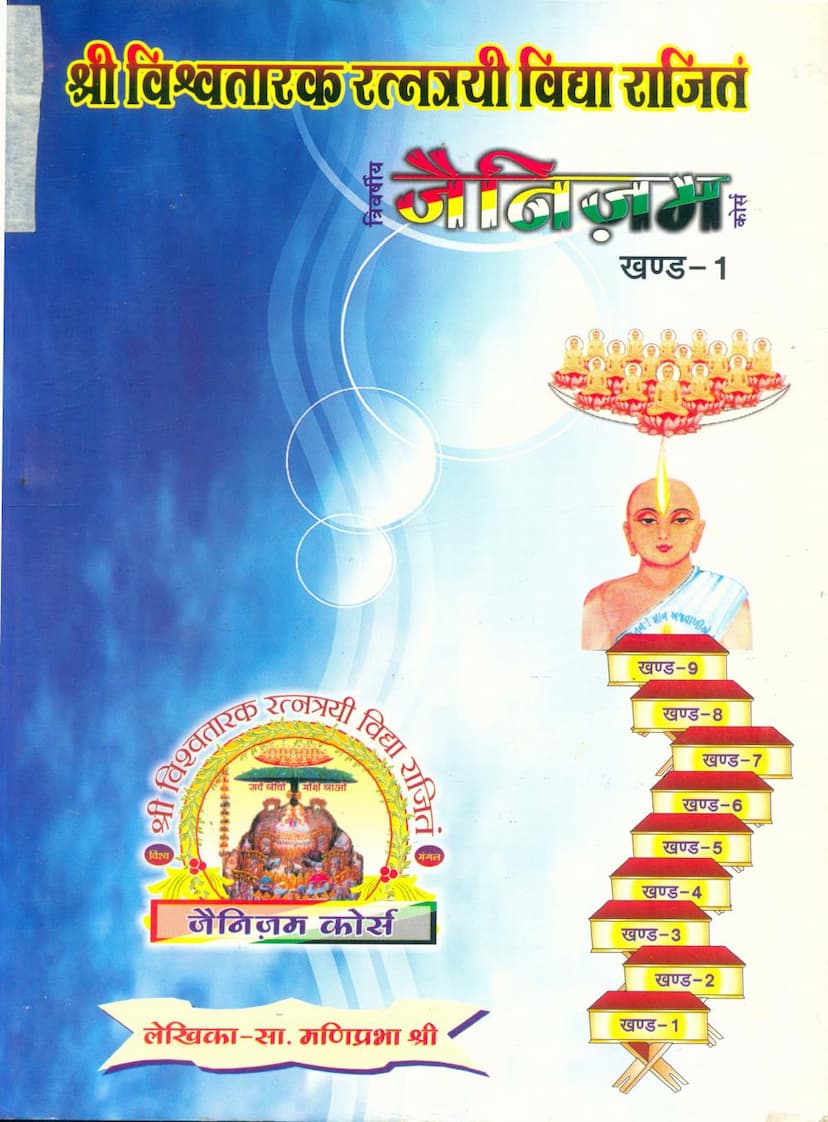Jainism Course Part 01
Added to library: September 2, 2025

Summary
This document is the first volume of a Jainism course titled "Jainism Course Part 01," authored by Sadhvi Maniprabhashreeji and published by Adinath Rajendra Jain Shwetambara Pedhi. The course aims to spread Jainism across villages and homes, fostering righteousness and guiding individuals towards spiritual liberation.
The course is structured into five chapters, each addressing a key aspect of Jainism:
- Kriya Shuddhi (Purity of Action): Focuses on purifying actions through righteous practices as taught by the Lord.
- Sukhi Parivar Ki Chabi (The Key to a Happy Family): Aims to transform life into a beautiful, harmonious experience of friendship.
- Sutra Arth Evam Kavya Vibhag (Sutra Meaning and Poetry Division): Encourages memorizing sutras and their meanings, as explained by the Gadhars (chief disciples of the Tirthankaras), to cleanse karmic impurities and achieve self-purification through devotion.
- Adarsh Jeevan Charitra (Ideal Life Biographies): Promotes following the footsteps of great souls to attain immortality.
- Jeev Vichar, Nav-Tattva, Karmgranthadi (Soul's Consideration, Nine Fundamentals, Karmic Texts, etc.): Aims to impart profound philosophical concepts like the nature of the soul, the nine fundamental principles of Jainism, and the intricacies of karma in an easily digestible, conversational manner.
The book emphasizes that Jainism holds the key to success and offers a path to a life filled with joy, peace, righteousness, and spiritual growth, free from suffering and bondage. It highlights the deficiency of strong moral and spiritual foundations in the current education system and positions the Jainism Course as a crucial element in building character and imparting essential values.
The initial pages include blessings and endorsements from prominent Jain Acharyas, including P.P. Rashtrasant Shiromani Gachhadhipati Vartamanacharya Devesh Shrimad Vijay Hemendrasurishwarji M.S. The author, Sadhvi Maniprabhashreeji, expresses her gratitude to her gurus and the supporting family members who contributed to the creation of this course.
The content of the course covers a wide range of Jain teachings, including:
- Jainology:
- Self-identity ("Who am I? I am the Soul.")
- The significance of the Navkar Mantra (the fundamental prayer in Jainism).
- The importance of gurus and their teachings.
- Principles of harmonious relationships and building Jain families.
- The essential practices and conduct of a Jain.
- The importance of adherence to Jain principles in daily life.
- Sutras and Their Meanings: Detailed explanations of various Jain sutras, including those related to daily prayers, rituals, and devotional practices. This includes the Namaskar Sutra, Panchindriya Sutra (Guru Stuti), Khama Samana Sutra (Panchaang Pranipat), Iryavahiyam Sutra (Pratikraman), and others.
- Jain History and Biographies: Stories of revered figures like Lord Mahavir, Gautam Swami, and Chandanbala, highlighting their exemplary lives, struggles, and spiritual achievements.
- Tattvajnan (Philosophy): Concepts like the soul's evolution, the Jain cosmology (Fourteen Rajlok), the Nine Tattvas, and the workings of karma.
- Vastu Shastra: Principles of Jain vastu shastra for creating harmonious living spaces.
- Lifestyle and Practices: Guidance on living a Jain life, including dietary restrictions (avoiding night meals, root vegetables), the importance of pilgrimage, and correct temple etiquette.
- The significance of various Jain festivals and observances.
- The role of Jain culture versus Western culture and the importance of preserving indigenous values.
- The concept of Liahsya (subtle energies affecting the soul) and how to cultivate positive Liahsya.
- The merits of righteous conduct and the consequences of unethical actions.
- A detailed explanation of the Navpad (Navkar Mantra) and its significance.
- The method of counting malas and the specific benefits of different types of malas.
- The importance of compassion and non-violence (Ahimsa) in Jainism, illustrated through various stories and examples.
- The science behind Jain practices, such as avoiding night meals and consuming specific foods.
- The detailed structure of the universe (Fourteen Rajlok) as per Jain cosmology, including descriptions of heavens, hells, and human realms.
- The story of the soul's journey through various life forms and the path to liberation.
- The philosophy of karma and its different types.
- The concept of Liahsya (aura/color of the soul) and its impact on one's life.
- Detailed explanations of temple worship, including the significance of various rituals, offerings, and prayers.
- The importance of observing specific Jain principles as a minimum standard for being a true Jain, such as temple worship, listening to scriptures, avoiding night meals, and abstaining from root vegetables.
- The consequences of adhering to certain practices, illustrated with stories and explanations of what leads to desirable outcomes and what leads to negative ones.
- The text also includes practical advice on various aspects of life, including health remedies, the importance of good manners, and the difference between Indian and Western cultures.
- The Open-Book Exam paper at the end tests the reader's comprehension of the material covered in the course.
The document is a comprehensive guide for individuals seeking to understand and embrace the teachings of Jainism, emphasizing ethical living, spiritual discipline, and the ultimate goal of liberation.